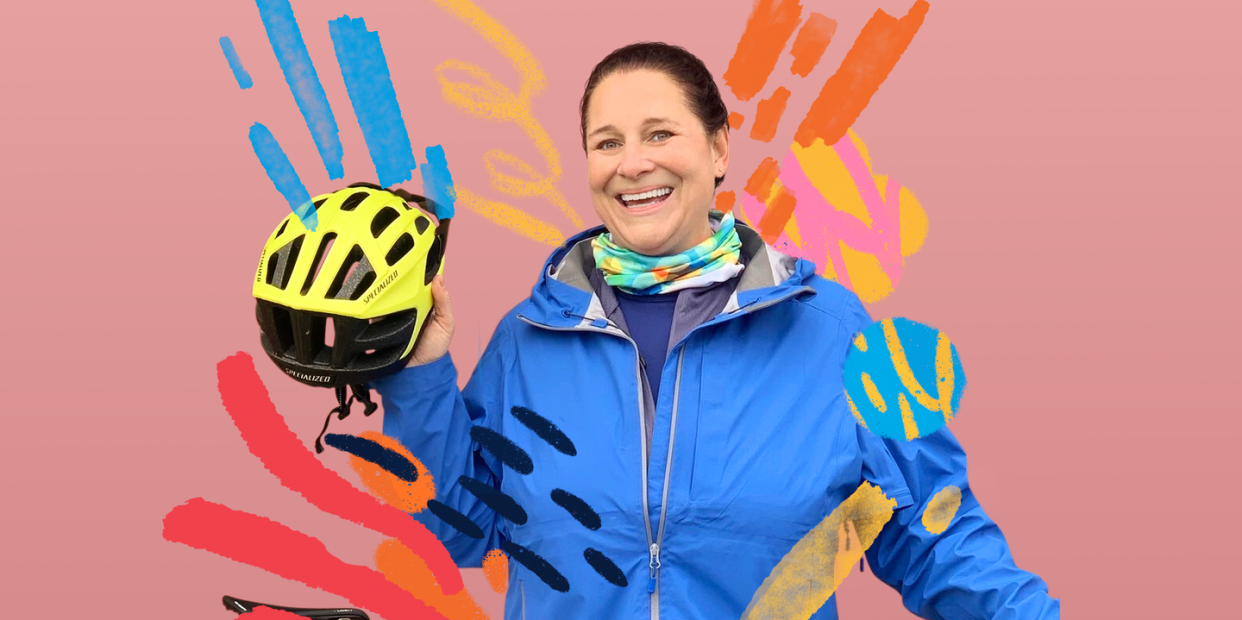Jennifer Weiner: ‘Size Exclusivity In Workout Gear Creates A Vicious Cycle’

Last fall, during the bleakest months of the pandemic, I desperately wanted human contact, exercise, and sunshine. Since I always loved riding my bike as a kid, cycled with a group all throughout my twenties, and biked in Cape Cod during the summer, I decided to join the Bicycle Club of Philadelphia in November.
Most cycling clubs are very welcoming for beginners. At my club, there are rides every Sunday where instructors cover skills like riding in traffic and how to use hand signals. But since I started riding during the winter, I needed to figure out what to wear.
Everybody says, “there’s no such thing as bad weather, there’s just bad clothes.” Turns out, that’s true! Once I understood how to dress for a 25-degree bike ride, it made such a difference.
It’s very easy to roll your eyes at people who say SmartWool changed their life, but I’m here to tell you that it can.
If you have the right clothes, you can bike on a 25-degree day, as long as there’s no ice on the road. (Not to mention, wearing a mask actually helps with the cold air.)
As a woman who wears an XL or 2XL, it’s difficult to find biking gear from boutique brands. Sure, you can go on Amazon and find gear that goes up to 2XL or 3XL—I bought my favorite winter tights for $35 on Amazon—but I’d much rather support a smaller, made-in-the-USA business run by women.
Bike jerseys are designed to be longer in the back to keep you covered while you’re riding, and they have pockets for gloves or a water bottle. Over the past few years, there has been an explosion of smaller cycling brands that sound fantastic on paper—women-run, extended sizes, and with “inclusive,” “empowering” messaging—but then when you get to the website, you see that there’s a limited plus-size selection, or major price hikes for larger sizes.
As a consumer, I understand that brands have to follow different patterns and fit models, and there’s always a gamble about whether plus-size garments will sell. As far as I’m concerned, if you build it, women will come.
I guarantee there is a market for the brand who tells women of all sizes that we’re welcome in cycling, that this is something we can do, and we can find clothes that make us feel comfortable and empowered.
I see women of all sizes who cycle, so I think brands just need to make us some damn clothes.
In my opinion, the brand doing the best job of being inclusive to plus-size cyclists is REI, which seems to have listened to their customers and expanded their plus selection over the past 20 years.
It might not seem like a big deal, but having the right gear helps you feel like you belong. If you’re in a bicycle club like mine, and you show up for a group ride wearing a t-shirt while everyone else has a cycling jersey, it can feel like you don’t know the secret knock to get into the clubhouse. (But if you prefer to ride in a t-shirt, more power to you.)
The sport of cycling has given me so much in terms of my mental health and happiness; I want it to be accessible to anyone who wants to do it. If somebody is browsing an activewear company that doesn’t make clothes larger than XL, she might think that she’s not welcome in the sport, and that would be a shame. I don’t want that happening to people.
Not to mention, size exclusivity creates a vicious cycle.
If you’re a plus-size woman and you don’t exercise, but you want to start exercising, buying the right activewear might be one of your first steps. If you want to do something other than running, or taking a workout class where you just need leggings and a top, you’ll likely need specialized equipment.
For example, if you want to ski, it’s very hard to find plus-size gear. You can’t find a jacket, you can’t find bibs, and most times, you can’t find ski boots that will buckle over your calves. If you can’t find clothes that will fit you, you might think the sport is not the right one for you, or you’re not welcome. And that might prevent you from giving it a try, or exercising at all.
According to the Centers for Disease Control and Prevention, exercising outdoors is one of the safer things we can do during the pandemic. Personally, I think it feels a lot safer than going to the gym right now. If you’re interested in cycling, I’d recommend checking out your local cycling club and going for a group ride to explore whether cycling improves your mental health the way it has mine.
You Might Also Like

